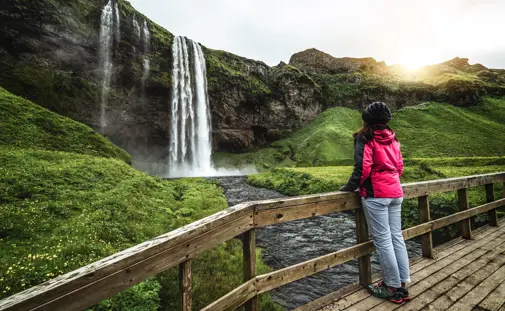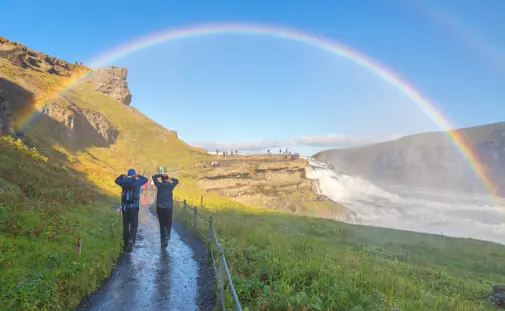Deildartunguhver Hot Spring
Deildartunguhver is the most powerful hot spring in Europe, located in the Borgarfjörður region of western Iceland. The area is open to visitors who can comfortably park their car and walk along the designated walking paths amidst the bubbling hot springs, free of charge.
This geothermal marvel produces a staggering 180 liters of boiling water per second, with temperatures reaching up to 100°C (212°F) at the source. The hot spring's intense geothermal activity makes it a vital resource for the surrounding area, providing hot water for central heating to nearby towns and villages, including Borgarnes and Akranes.
In recent years, the hot spring has also become a key attraction for visitors to the Krauma Spa, a nearby facility that harnesses the spring's geothermal energy to provide relaxing thermal baths and wellness experiences.
Deildartunguhver Facts
Deildartunguhver is Europe’s most powerful hot spring and serves over 8700 people, living in the vicinity, with hot water.
-
Water Temperature: Constantly around 100°C (212°F) at the source.
-
Flow Rate: Approximately 180 liters (47 gallons) per second, making it the most powerful hot spring in Europe.
-
Use of Water: Supplies hot water to the nearby towns of Akranes and Borgarnes through a 64 km (40 mi) pipeline.
-
Distinctive Vegetation: Rich in green ferns, particularly the rare "struthiopteris" fern, which thrives in the geothermal warmth.
-
Safety Caution: Due to high water temperature, approaching the water source directly is prohibited.
History & Geology
Deildartunguhver has been a part of the Icelandic landscape for thousands of years. In fact, due to the overall volcanic nature of Iceland and scarce fuel supplies in earlier days, hot springs were used for cooking and washing. In the 20th century, the popularity of Deildartunguhver increased with its water being harnessed for heating houses. By the 1970s, there was a geothermal pipe laid down transporting hot water for 64 km (40 miles) to nearby towns, reducing in that way dependency on imported fuels while pioneering sustainable energy.
Geologically speaking, the main feeding source of Deildartunguhver is deep inside the Mid-Atlantic Ridge, where tectonic plates pull apart, creating strong geothermal activity. This results in underground pressure forcing mineral-rich water up to the surface, forming boiling springs at a remarkably consistent flow rate throughout the year. The soil, rich in minerals around this geothermal areaGeothermal Areas, allows for rich and diverse vegetation. This includes the Tunguskollakambur ferns that grow nowhere else in the world, according to current research, making for a very peculiar ecology around the hot spring area.
What to Do at Deildartunguhver
Several options allow visitors to enjoy Deildartunguhver, one of the most powerful naturally occurring hot springs in Europe.
The nearby geothermal spa, Krauma, mixes its boiling water with cool spring water to achieve very relaxing pools at safe, pleasant temperatures. This is further complemented at Krauma Spa with steam baths, a relaxation room, and locally sourced meals through its restaurant, hence offering in great comfort a chance to really enjoy Deildartunguhver's geothermal energy.
If relaxation is not in the cards, then beautiful walking routes are also offered in the surrounding area from Deildartunguhver, where visitors can take in the rare landscape, observing geothermal vents up close, along with peculiar ferns that do extremely well in geothermal heat. Photography enthusiasts will find plenty of opportunities for steam-filled scenery together with lively greenery, contrasting elegantly with Iceland's dark volcanic rock.
The Loneliest Ferns in the World
140 some years since their discovery, in 1876, the ferns that grow at Deildartunguhver have been researched properly and are confirmed to indeed be one of a kind. These ferns called Tunguskollakambur, Struthiopteris fallax, grow nowhere else in the world but at Deildartunguhver hot spring [1], according to recent studies, making them the loneliest ferns in the world. However the ferns now enjoy their unique status and have been protected by law since 1978 [2]. You can view these peculiar plants next to the hot spring’s walking paths.
It’s also thanks to the protected status of the ferns that a structure was not built over Deildartunguhver when the hot spring was activated for the purpose of heating houses in Akranes and Borgarnes, in 1979.
Fresh Tomato Soup and Greenhouse
Make sure to stop at Staldrið, a food truck parked outside the greenhouse, for a homemade tomato soup. The tomatoes are freshly picked from the plants within the greenhouse, that’s further heated by Deildartunguhver. You can sit inside the greenhouse and enjoy your food and sometimes you can also buy fresh tomatoes for the road straight from the plants.
Deildartunguhver & Nearby Attractions Map
The area around Deildartunguhver is full of natural wonders, historical sites, and scenic stops, which ultimately makes it a prime spot for exploring West Iceland. A short drive from Deildartunguhver are Hraunfossar and Barnafoss, two of Iceland's most famous waterfalls, each spurred by different geographical elements and folklore. Hraunfossar cascades through the porous lava fields in an extraordinary display, while Barnafoss is steeped in more violent waters, local legend, and history.
Another interesting location in the area is Reykholt, which has a very strong connection with the medieval poet and scholar Snorri Sturluson. Reykholt contains a cultural center, medieval research institute, and the old pool Snorralaug, which was used by Sturluson himself. For those seeking relaxation, Krauma Spa does just that: it is a retreat along Deildartunguhver with geothermal hot tubs, cold pools, and steam rooms, all powered by the natural energy of the hot spring.
Also within easy reach is Víðgelmir Lava Cave, one of Iceland's largest lava tubes. This breathtaking site offers guided tours leading visitors through vibrant formations and vast chambers, a truly memorable journey through Iceland's volcanic underworld.
These nearby attractions enhance the experience of visiting Deildartunguhver, creating a richly diverse itinerary for those exploring West Iceland.
Deildartunguhver Location
Deildartunguhver is situated in West Iceland, close to the town of Reykholt and within a two-hour drive from Reykjavik, making it easily accessible for day-trippers or those touring Iceland’s western coast.
-
Deildartunguhver Location: 64°39'49.5"N 21°24'38.4"W
How to Get There
From Reykjavik, take Route 1 north to Borgarnes, then turn onto Route 50 and continue to Reykholt. Finally, follow Route 518, where you’ll find Deildartunguhver clearly signposted. The drive is approximately 100 kilometers (62 miles) and takes around 1.5 hours.
Parking and Facilities
There is a free parking lot for visitors near the hot springs, with signs pointing guests to the area’s walking paths and viewing platforms. Due to safety considerations, there are fences and barriers around the hot springs to prevent accidents, as the water reaches boiling temperatures. At the geothermal area of Deildartunguhver itself there are no bathroom facilities, but at the Krauma Spa, right next to the site, are full facilities for those visitors looking to bathe in the hot spring or dine at the restaurant and café
Deildartunguhver in Winter
Deildartunguhver remains accessible year-round, providing a unique spectacle in winter when the geothermal steam contrasts dramatically with snow-covered surroundings. Visitors may be lucky enough to see the Northern Lights at Deildartunguhver in winter, as the area’s low light pollution creates favorable conditions for aurora viewing.
Krauma Spa which usually closes at 9pm is the perfect winter experience to enjoy the starry night sky on a crisp evening. Although open late, the baths are usually not open long enough for aurora viewing as the lights usually appear later at night.
Sources
-
"Tungusköllakambur kannaður". Náttúrufræðistofnun Íslands. Archived from the original on September 5, 2022. Retrieved from https://www.ni.is/is/frettir/2022/09/tunguskollakambur-kannadur.
-
"Auglýsing um friðlýsingu plantutegunda". Umhverfisstofnun. Archived from the original on March 1, 1978. Retrieved from https://www.ust.is/library/Skrar/Einstaklingar/Fridlyst-svaedi/Auglysingar/r_184_1978_auglysing_plontutegundir.pdf.



